Real Madrid’s win over Getafe gave them a four-point lead over Barcelona. With the race to La Liga’s crown firmly under their control, Los Blancos are five matches away from their 34th league title.
Before the club starts popping Champaign bottles, completing this difficult stretch of matches is key. A late winner against Getafe put them in the drier seat, but an equally difficult task awaits Zinedine Zidane’s men as they travel to surging Athletic Club.
With three wins in the past four matches and 11 points in six games since the restart, the performances of the Basque side have catapulted them into Europa League contention. Once a distant objective, European play is now within the grasp of Gaizka Garitano’s side.
In this tactical analysis, we’ll examine the matchup between Athletic Bilbao and Real Madrid. With Madrid expected to have approximately 65% of possession, we’ll take an in-depth look at Bilbao’s defensive structure through the phases, showing how they hope to dictate play through defence. Understanding how Real Madrid will attack the Athletic Club defence will follow, proceeded by an examination as to why neither team can rely on counterattacking success in this matchup, which greatly hinders Athletic Club’s odds of scoring.
Predicted Lineup
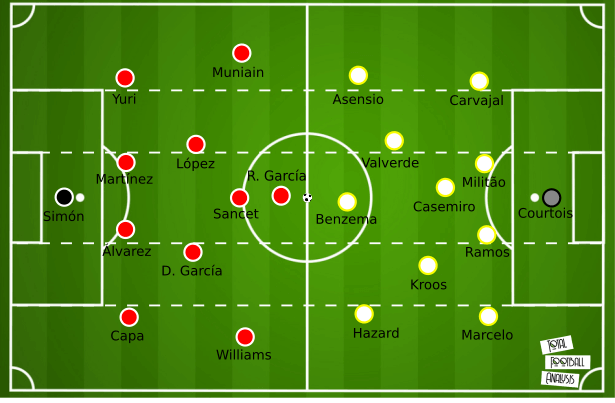
Athletic Club’s predicted lineup (4-2-3-1)– Unai Simón; Ander Capa, Yeray Álvarez, Íñigo Martínez, Yuri Berchiche; Dani García, Unai López; Iñaki Williams, Oihan Sancet, Iker Muniain; Raúl García
With Athletic Bilbao needing a result to stay alive in their bid for a Europa League spot, expect Garitano to field a more attacking side. García has started a couple of matches in a row, so there’s a chance he’s rested, moving Williams to the top of the formation, but García’s goal-scoring form is desperately needed in this match. Look for the youngster, Sancet, to earn another big start with Muniain to his left.
Real Madrid’s predicted lineup (4-3-3)– Thibaut Courtois; Dani Carvajal, Éder Militão, Sergio Ramos, Marcelo; Casemiro, Toni Kroos, Federico Valverde; Marco Asensio, Karim Benzema, Eden Hazard
With Luka Modrić playing in the last match and Vinícius Júnior starting in three of the past four games, they’re prime candidates to sit. Expect Hazard to start on the left, Valverde starting in place of Modrić and Marcelo’s return to the lineup. With Varane doubtful for the clash, look for Militão to get the nod next to Ramos. The right-forward spot offers Zidane plenty of options. While this is a great time for Asensio to start, there’s also the possibility of Rodrygo in the XI or Vinícius Júnior starting and rotating sides with Hazard. The right-wing is a wildcard.
Athletic Club’s defensive phases
With a 1.10 xG per 90 output, Athletic Club is not a team that generates a lot of high-quality scoring chances. While their xG rating has improved to 1.19 since the restart, this is a side that likes to dictate play through defence. With a narrow, compact defensive structure, their objective is to force the opposition to overcommit, then take advantage of uncontested space and qualitative advantages higher up the pitch. Claiming only 45% possession in the previous six matches, Athletic Bilbao’s deliberate deferring of possession to the opponent has produced fewer shots than their season average, but a higher quality xG per shot.
To set up this direct style of attack, Bilbao starts the match with an aggressive high press. This approach is typically applied in the first 15 minutes of the match. The objective is to unnerve the opposition. Despite the high-pressure induced goal against Valencia, this is not the club’s modus operandi. In those first 15 minutes, the side will usually commit the attacking midfielders and forward to the press. Gaps emerge between that group and the defensive mids, making the press fairly easy to beat.
In the recent match against Barcelona, Bilbao shot out of the gates, pressuring Barcelona across the pitch. However, as you can see in the image below, Barcelona’s numeric superiority allowed them to beat the press rather easily.
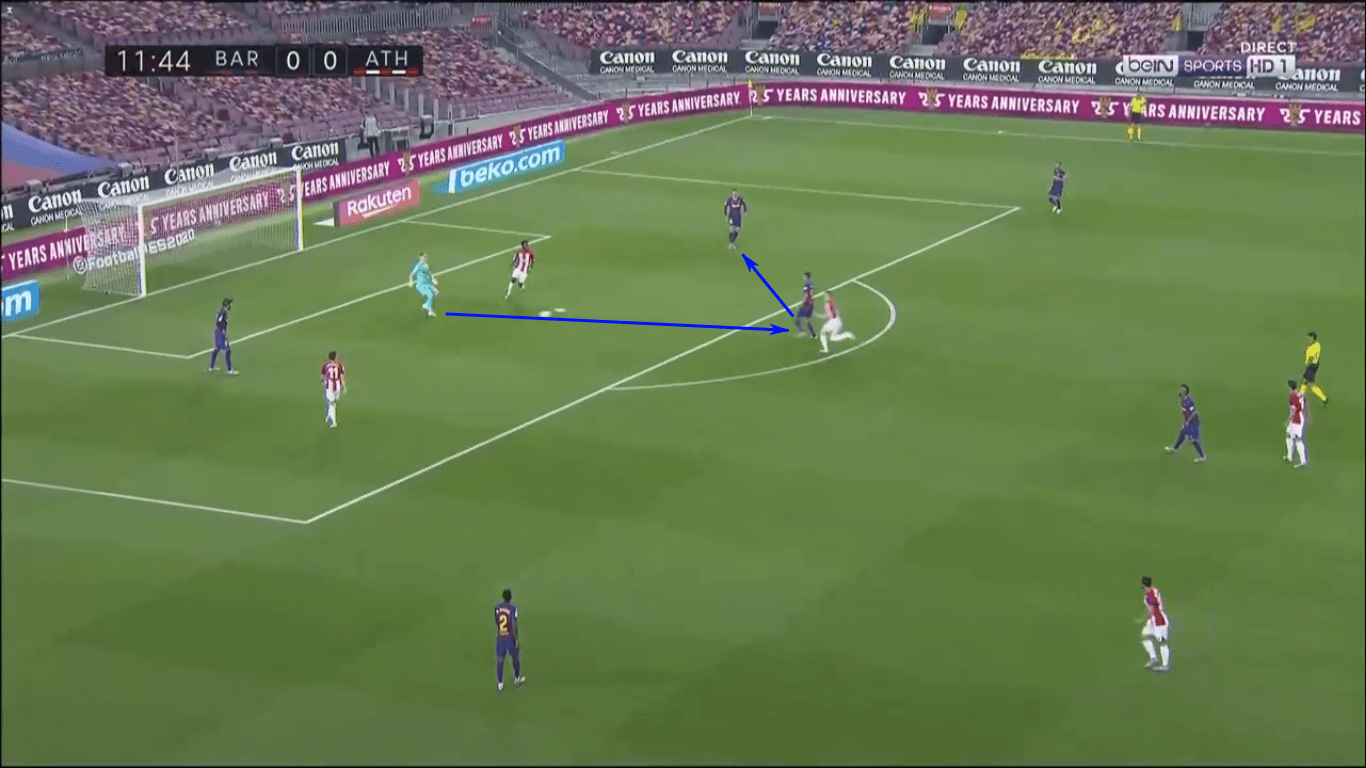
With the first line beat, Barcelona was able to progress to midfield rather easily. However, once they reached midfield, Athletic’s remaining players behind the ball were very successful in delaying the pace of the Barcelona attack, giving the attacking midfielders time to take up their spots in the side’s defensive structure.
In this matchup, delaying the Madrid attacks, especially if they play directly to Hazard or one of the other forwards, will be key. Athletic’s rest defence must account for the forwards, denying entry passes when possible and delaying the Madrid attack when they can’t cut out passes. Whereas Madrid should prepare for the high press, looking to score before Bilbao can reset their lines.
After the first 15 minutes, look for Athletic Bilbao to primarily defend in a middle block. You will see them drop off, preferring the more compact structure of the middle block. Denying entry through the central channel and contesting play in the half-spaces are foundational to their defensive approach.
The image below is a progression from the one above. As mentioned, Athletic Club looks to halt the opposition’s attack near midfield. With the attack slowed, the players took up the standard middle block. Though they’re a 4-2-3-1 club in attack, they typically defend in two banks of four with one of the forwards dropping to the opposition’s holding midfielder.
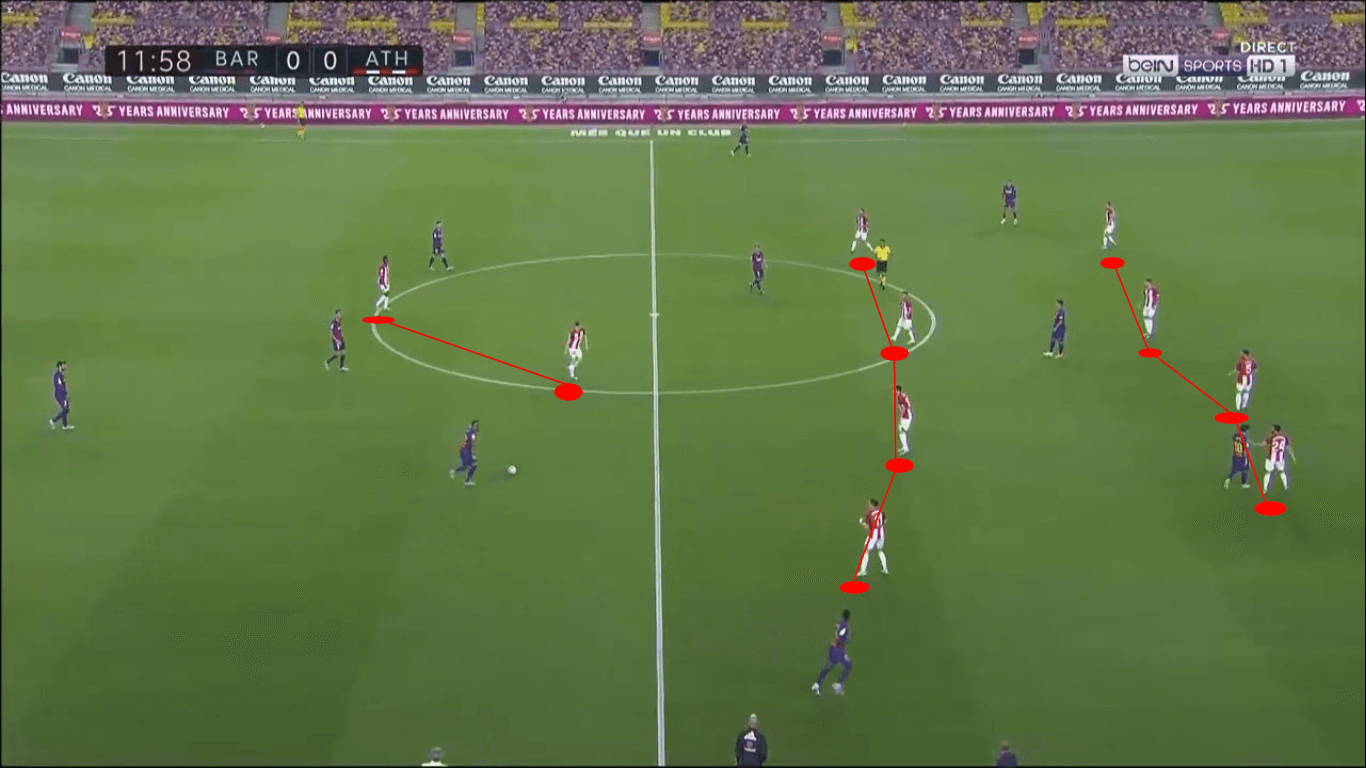
Bilbao invites the opposition to commit numbers forward, clearing space for their high attacking players to engage in 1v1s higher up the pitch. The middle and low blocks allow Bilbao to transition from defence to the attack by keeping two high targets. With the opposition pushed high up the pitch, those outlet passes to the high targets are easier to complete.
As shown in the image below. they used this same approach against Real Madrid in the first matchup. As Real pressed into the attacking half of the pitch, the Bilbao forwards tended to remain near midfield, offering a direct passing option. Skipping the lines puts their attackers, especially Williams, in position to use their pace and physicality in 1v1 situations. Sitting deeper also guarantees the opposition has a longer recovery run to offer help against the Bilbao forwards and attacking mids.
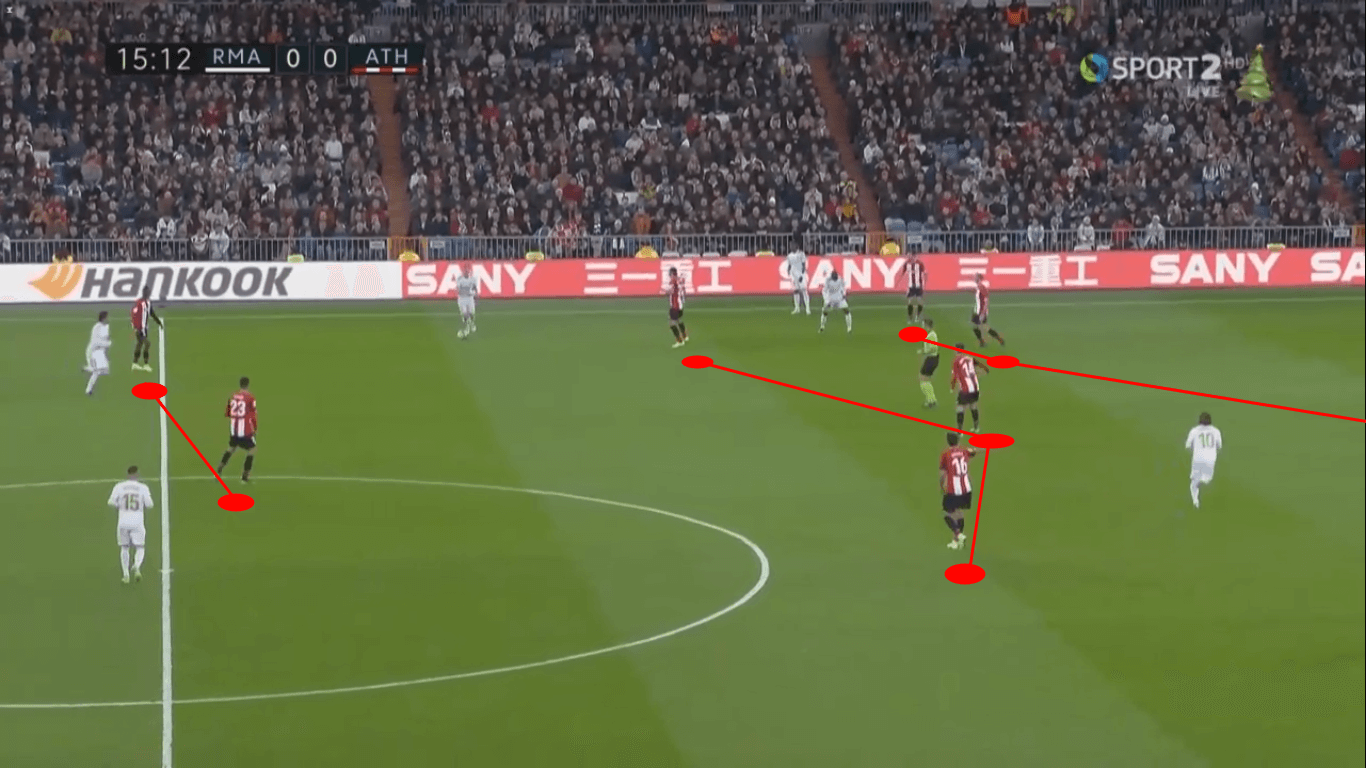
In terms of their transition to the low block, Bilbao will drop eight field players back to deal with the attackers moving forward. In the first matchup of the season, Bilbao actually used a 5-3-2 to ensure numeric superiority deep in their end, as well as defend against Madrid’s crosses. While I don’t think they’ll play the 5-3-2 in this matchup, do expect Bilbao to err on the side of overcommitment when they transition into the low block.
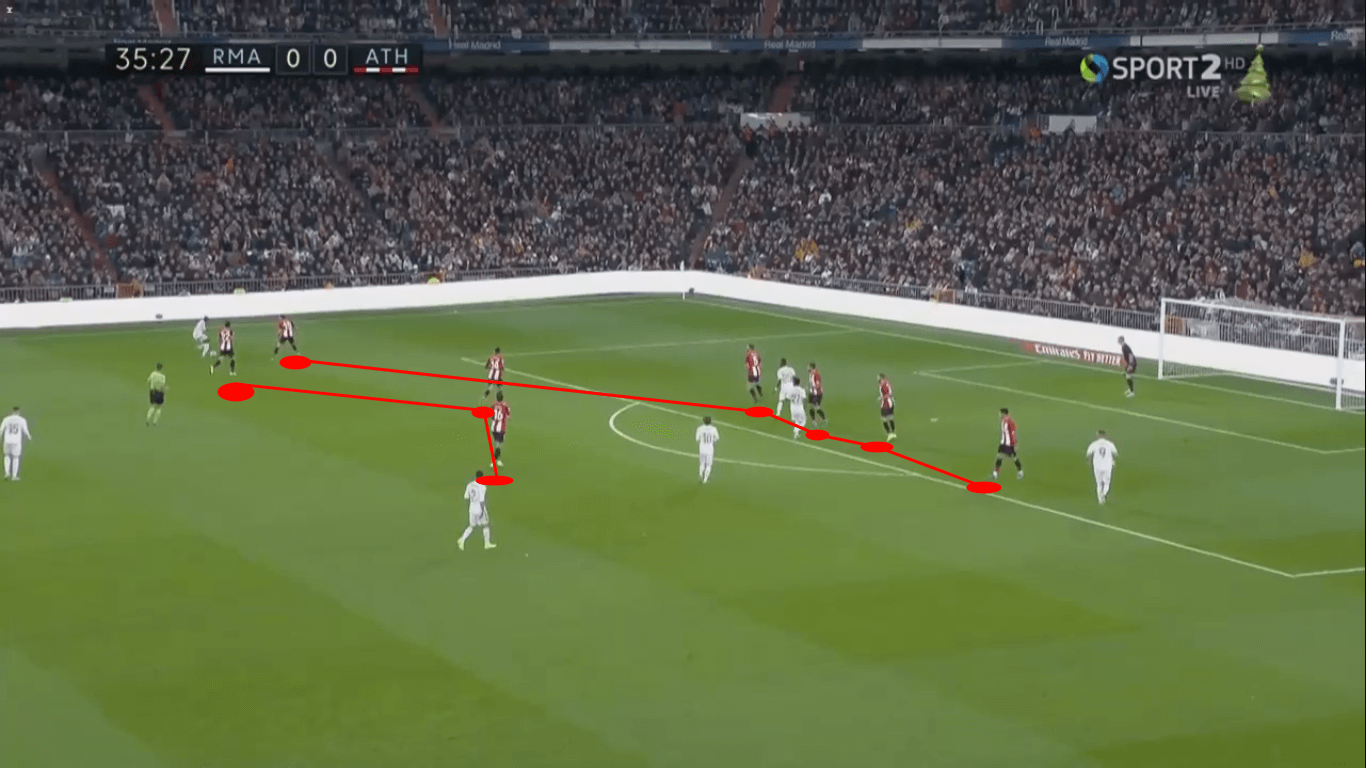
Though Athletic Club’s attacking tactics resemble those of Getafe, the defensive tactics alter the starting points of the attack. Against Getafe, Real routinely had numbers around the ball to counter-press a loss of possession. In this matchup, Bilbao’s philosophy of sitting deeper in defence will invite the Real Madrid attackers to push forward, creating the attacking conditions Bilbao desires. Athletic’s attack starts with their defensive shape.
The importance of width for Real Madrid
Outside of the first 15 minutes, Real Madrid must prepare for an incredible compact opponent. If there are bright sides to this matchup, it’s that Real Madrid is in fine form, even despite the heavy rotations, and Bilbao is averaging 1.42 xG per match while conceding only 0.83 goals per 90. The numbers indicate that Athletic’s opponents have been wasteful in front of goal rather than the Basque side’s defensive domination. Madrid knows that wastefulness all too well, recording a phenomenal tally of 2.51 xG to Bilbao’s 0.56 xG in the last matchup. Despite the reasonable expectation of three goals in the game, the final score was 0-0, which included a few open-net misses for Madrid.
After a slow start to the match, Real Madrid started to find lots of space in the wings and the outskirts of the half-spaces. Funnelling play into one of the wings would cue a switch of play to the opposite wing or half-space. Quick ball circulation clearly benefitted Madrid, but so did the rigidity of the Bilbao defence. With the Basque side moving in a predictable pattern, the Madrid attackers started using Bilbao’s movement across the pitch against them. As Bilbao’s lines moved in relation to the ball’s position, gaps emerged and Real Madrid started moving into these pockets of space.
Another pattern of attack was a central build-up with through passes to the wide forwards. Using their numeric superiority in the central channel and half-spaces, Madrid’s defenders and midfielders enjoyed a rondo around Bilbao’s front four. While the backline and midfield possessed, Real’s wide forwards took up high and wide starting points. If the defender didn’t move wide with them, one of two things would happen. First, Benzema would drop into the midfield and the wide forward would make a run into the half-space or central channel. Since there was no expectation of a pass, this decoy run aimed to catch the attention of the wide defender, then pull him into a wider starting point.
If that didn’t work, a second pattern played out. Kroos and Modrić, the two wide midfielders in the first match, would drop deeper, pulling the Athletic Club midfielders higher up the pitch. When they stepped, the Madrid midfielder would dash behind them into the half-space. A pass to Kroos or Modrić in that position forced the Bilbao backline to move laterally to cover the new threat. As the near-sided outside-back moved wider, Madrid’s wide-forwards were cued to make diagonal or horizontal runs into the 2/4 (right-back and right centre-back) and 3/5 (left-back and left centre-back) gaps. The image below shows Benzema dropping, Kroos receiving behind the Bilbao midfield and Vinícius Júnior making the corresponding run.
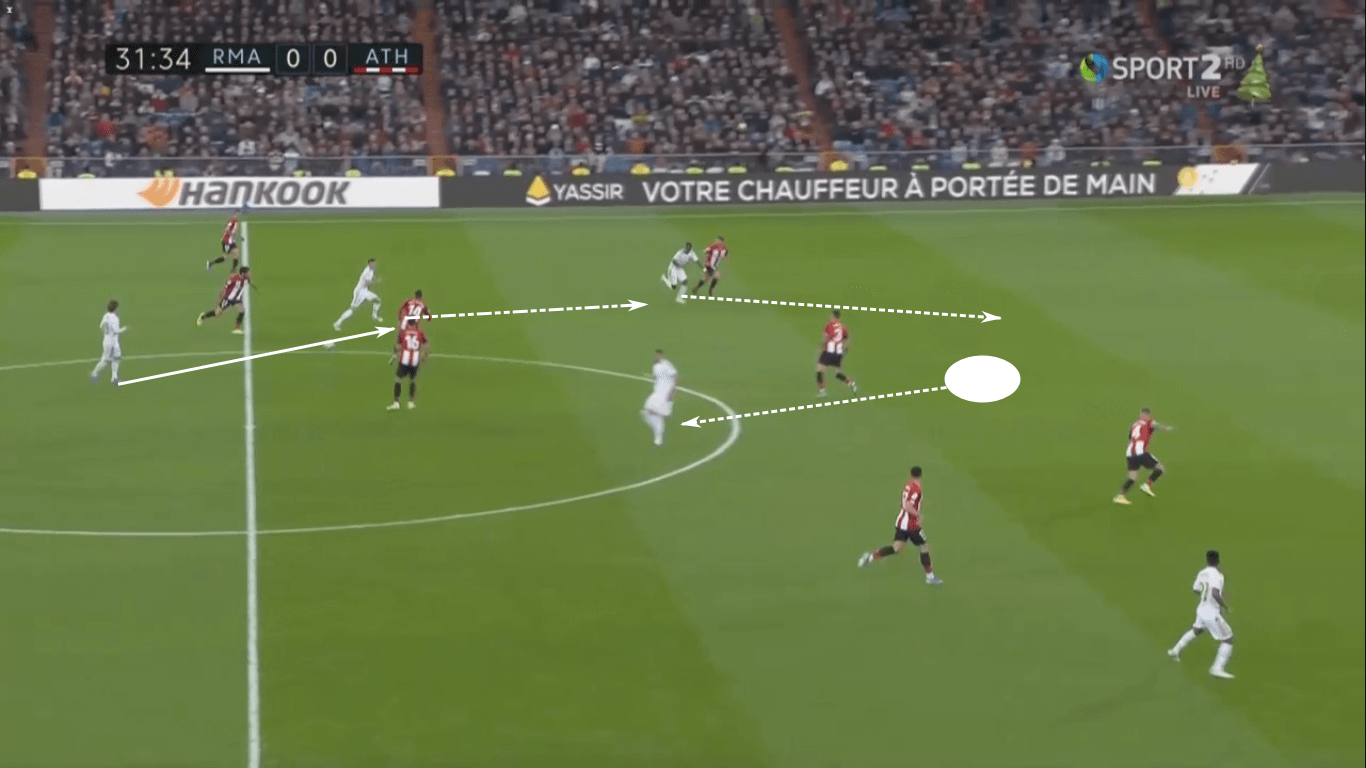
Instead of playing Vinícius Júnior through the 2/4 gap, Kroos dribbled forward. Vinícius Júnior continued his run forward to pull his mark away from the play. Since Unai Núñez had to step forward to delay Kroos’ progress, another pocket of space emerged, this time for Benzema in the central channel. Martínez’s step was a split second late, but the real damage was done when the ball ricocheted off of him, then back off of Benzema, sending the Frenchman onto goal. Rather than shooting from the top of the box, he rounded Simón and saw his shot cleared off the line to Vinícius Júnior, who couldn’t finish.
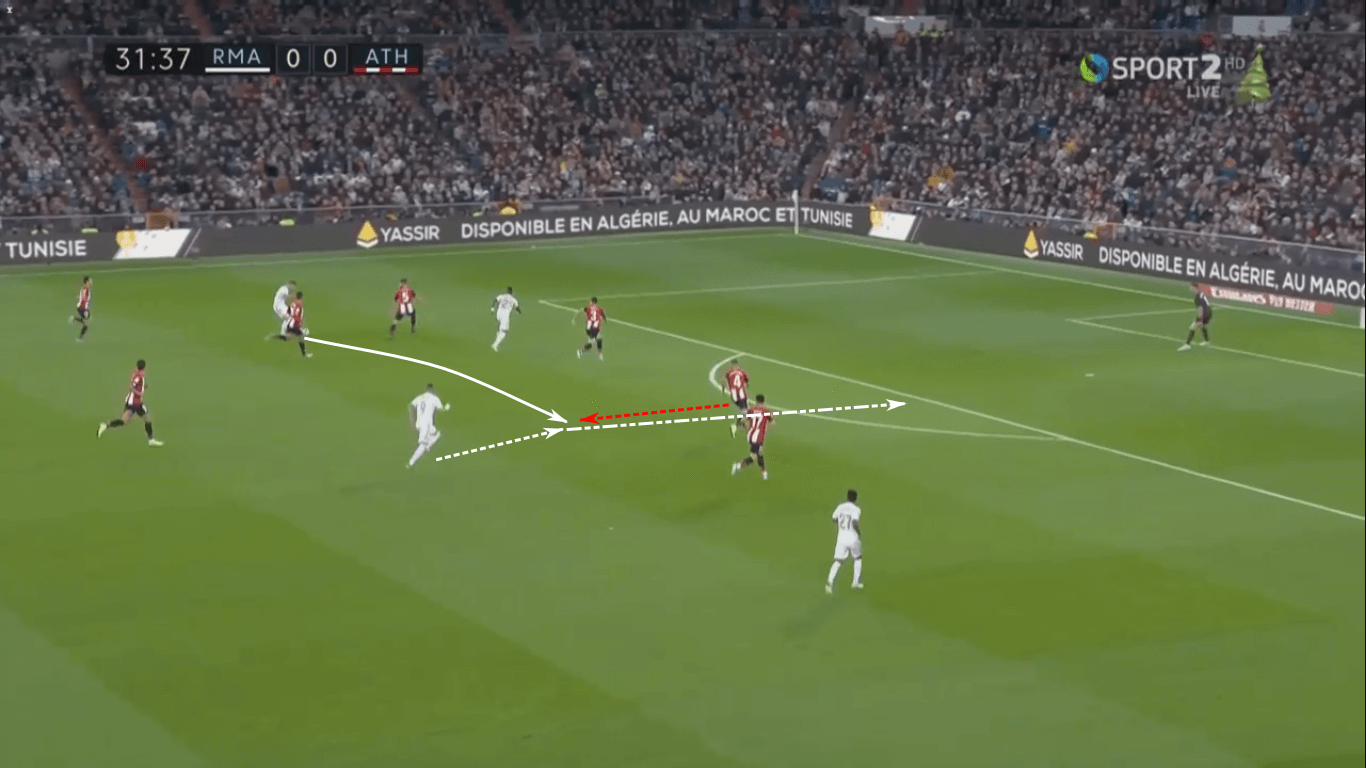
After a slow start to the first 25 minutes of the match, Real Madrid really started to control the match. Moments after his miss, Vinícius Júnior displayed his explosive dribbling ability, progressing the ball through the wing. His moment of brilliance cued Athletic Bilbao to send extra help. As help moved wide, the pass came central to Kroos.
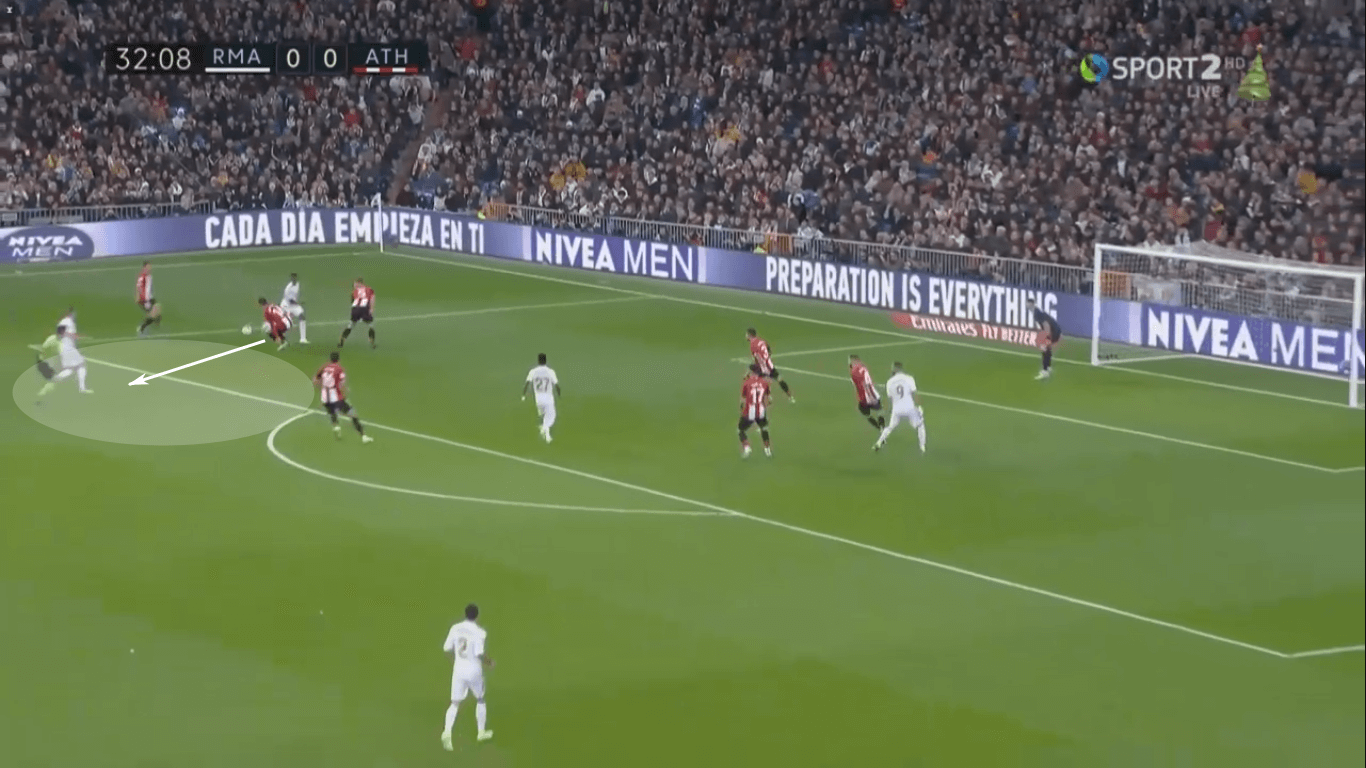
Despite their excellent defensive record, Bilbao greatly struggled with Madrid’s qualitative superiority in the wings. With the first defender beat, coverage wasn’t able to arrive in time to prevent negative passes to Madrid’s midfielders (or Benzema after a check into midfield). Though their 4-4-2 defensive work is highly structured, higher quality opponents are routinely able to take advantage of the space between the lines. You have to assume Real Madrid will look for those gaps once again.
Even when the central and half-space gaps don’t emerge, Real can still target the narrowness of Bilbao’s lines. Barcelona was able to do just that. In the sequence below, Luis Suárez had just made a run to the goal and was recovering his attacking shape. Bilbao didn’t account for his recovery. Instead, they kept their lines at a 20 metres range in the central channel. Their line was so compact that a simple pass to Suárez nearly gave Barcelona a second goal.
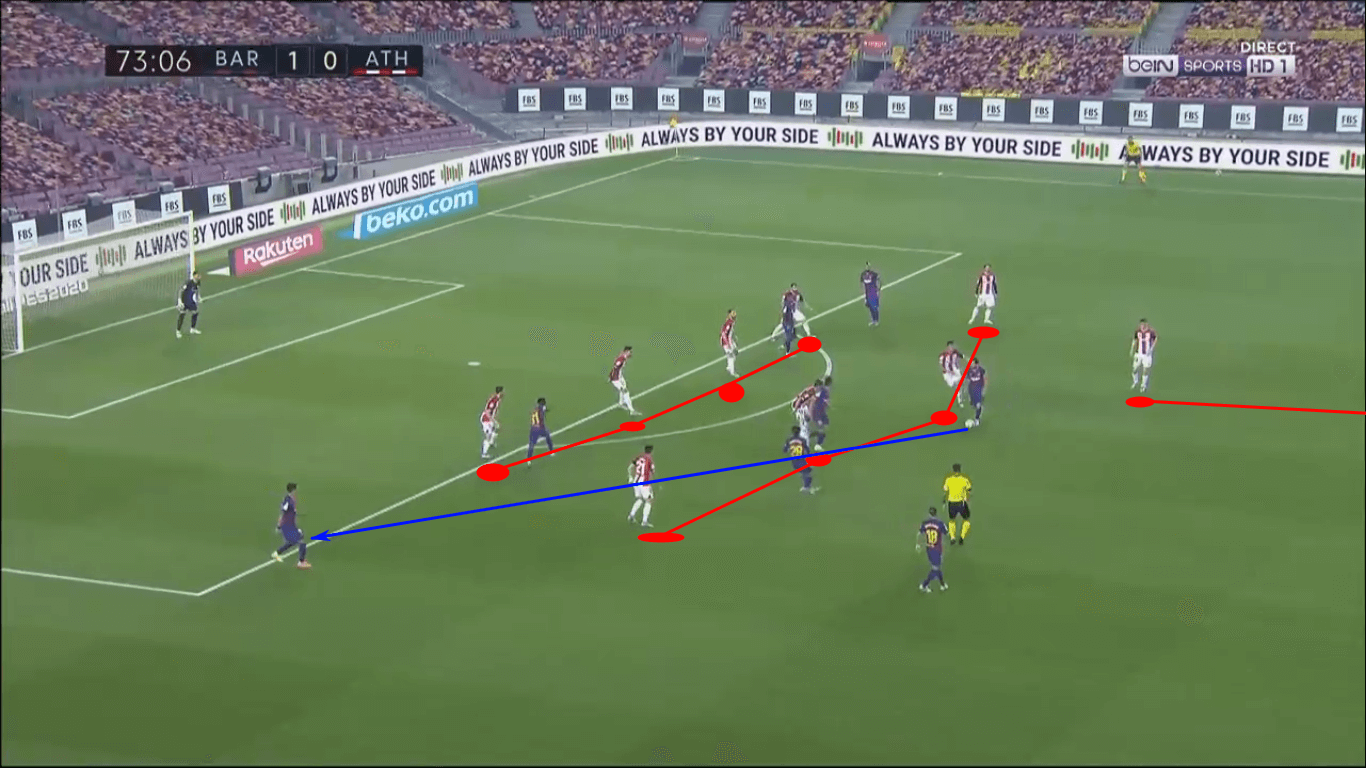
Moving the Bilbao backline with quick ball circulation is the key to Real Madrid’s attacking success. As Bilbao moves laterally and diagonally, gaps emerge. The sheer number of 1v1s with the keeper and high xG opportunities show that the last match came down to Madrid’s failure in front of the net more than Bilbao’s defence limiting Los Blancos’ attack. Madrid showed they could exploit the gaps in the previous matchup, they simply couldn’t finish off the attacking moves. With Madrid’s attack showing better form since the restart, expect higher quality finishing in this match.
Expect low success rates of counterattacks
Athletic Bilbao, as mentioned in the first section, looks to create counterattacking situations from middle and low block defending. For the season, they average 2.91 counterattacks per match, with 27% ending in a shot. On the other side of the ball, Real Madrid’s well known for quick counters as well, recording 4.28 counters per 90 with 30% ending in a shot. Despite each team typically enjoying their share of counterattacks, don’t expect much to come from them in this match.
According to Wyscout, Real Madrid has faced nine counterattacks since play restarted last month. Of those nine attacks, opponents were only able to record one shot. Athletic Bilbao has seen six counterattacks in that time, allowing just one shot.
The primary reason for their opponents’ lack of success is rest defence. When these two teams are in possession, they’re incredibly well set to snuff out attacks before they can properly start. In the image below, Valencia, a team very reliant on the counterattack, has just won the ball and started their attacking move. Notice the box of defenders Bilbao has behind the ball, as well as the recovery run of Capa on the right side of the pitch. Upon winning the ball, Valencia fins themselves 1v2 up top, the central passing lane cut out and a defend to pressure the ball-carrier.
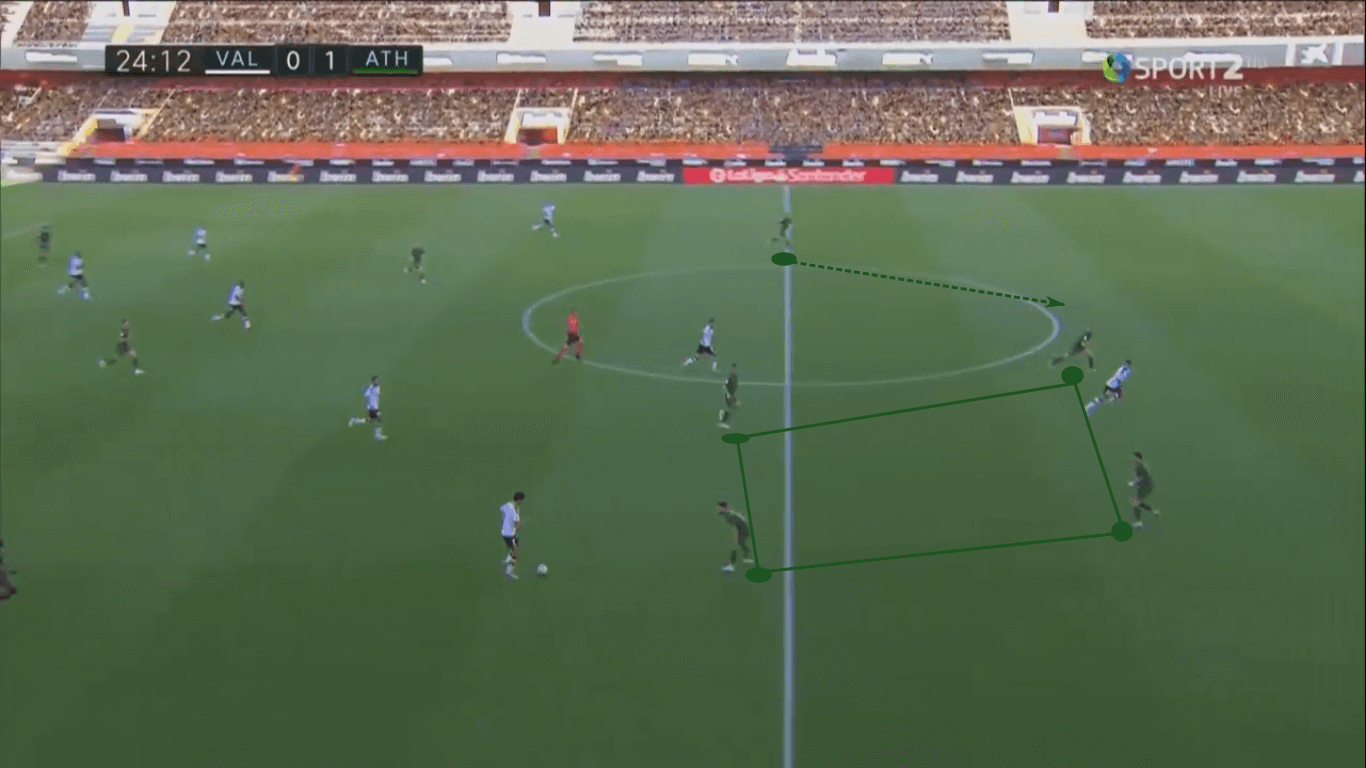
Real Madrid has a very similar rest defence. Although it’s common to see the outside-backs higher up the pitch, the centre-backs, Casemiro and Kroos typically form a central box themselves, funnelling the opposition wide and intercepting the majority of balls that enter the central channel. This example from El Derbi Madrileño shows their fantastic starting points and quick pressure on the ball-carrier forcing Atlético Madrid into the wing, delaying, then ending, the attack.
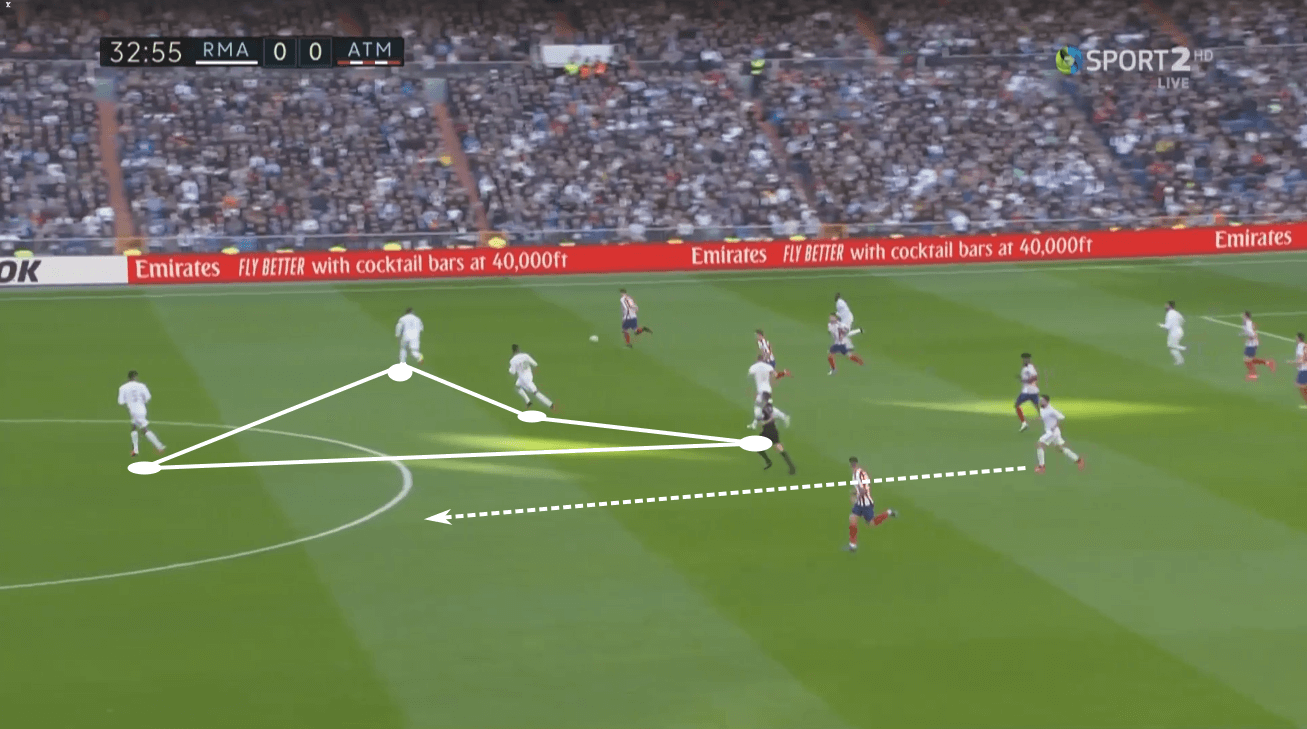
With both sides so well-positioned to defend the counterattack, don’t be surprised if there are few in the match and, when we do see one, that it’s unsuccessful.
Conclusion
This match has major implications for each team. For Athletic Club, they simply can’t afford to drop any points. Trailing Getafe by four points, a loss could see them fall seven points out with four matches to play, which would surely end their dreams of continental play.
For Real Madrid, it’s a chance to move seven points ahead of Barcelona. With the Catalans playing a surging Villarreal side in the evening, an early win for Madrid would heap the pressure upon Barcelona’s sputtering side.
Though the recent history of these two sides suggests the match ending in a draw, Athletic Bilbao’s has had some defensive issues since the return to play. After a thorough analysis, a one-goal margin is likely, but I’m going to go out on a limb and say 2-0 Real Madrid.





Comments